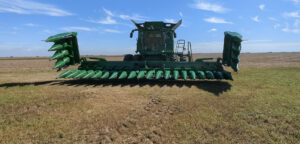There’s a silent stress growing across rural America. Farmers are focused on growing this year’s crop, hoping to outyield the low commodity prices. They’re keeping their head down and trudging through the day-to-day grind, but their angst can’t be ignored. Many farmers say they have a gut feeling 2024 will go down as the worst financial year they’ve ever had.
The reality is glaring. USDA’s net farm income forecast for 2024 is a $43 billion drop from 2023 to $116.1 billion. That is a 25.5% decline in just one year. What makes it even more jarring is that follows the 2023 net farm income figure, which saw a 16% drop from 2022. If USDA’s forecast holds true, that will mark the most significant two-year farm income decline in U.S. history.
“The $90-billion drop over a two-year period is certainly the largest dollar value drop, adjusted for inflation, that we’ve seen in our history,” says Ben Brown, an agricultural economist with the University of Missouri. “It exceeds the previous record set in the mid-1970s. When it comes to percentage changes, we’ve seen larger percentage changes. But you’d have to go all the way back to the Great Depression era and the early 1930s to find bigger percentage declines.”
However, 2023 may end up being even worse than what USDA currently has projected.
As USDA showed in the June Grain Stocks report, farmers are still holding onto a lot of their 2023 crop. In fact, USDA thinks on-farm storage is the highest since the 1980s. The reason: as commodity prices fall, farmers are reluctant to sell below the cost of production. That means USDA’s 2023 net farm income forecast may be even worse than what it is today.
“The big change I think we could see in an update would be the 2023 farm income numbers revised lower even from where they were,” says Brown.
Farmers aren’t just caught trying to market the current crop growing in fields today. Many still have last year’s crop sitting in bins. And corn and soybean prices are seeing another bloodbath to close out July.
Farmers Hope to Outyield Low Prices
Wading through a sea of soybeans, Arkansas farmer Becton Bell stares at one of his best crops ever, and he’s trying to focus on that positive right now.
“We’ve had a pleasant year,” says Bell, who farms in Mississippi County, Ark. “Rains have been, for the most part, pretty timely.”
The reality for Bell and other farmers marketing 2024 crops currently is they face, potentially, deep economic losses.
“It’s been the markets, to be honest,” says Bell, when asked what his biggest challenge is this year. “There just hasn’t been a good marketing opportunity. It’s kind of like catching a falling knife, trying to market soybeans and corn. Nobody wants to catch that falling knife.”
In his area of Arkansas, farmers rely on irrigation. And even though he’s irrigated some this season, timely rains have helped reduce the need to irrigate as much as usual.
“We’ve probably irrigated half of what we normally do so, you know, it could very easily mean several hundred-thousand-dollar savings to our bottom line,” he says.
Those doses of rain and short spurts of heat in northeast Arkansas mean growing conditions there have been like a greenhouse this year.
“It’s just almost scary to say this, but rains have been almost perfect as far as our timing goes,” says Bell. “Our corn crop looks like it could be one of our best corn crops we ever had, as does our soybean crop. So, I’m optimistic about the crops.”
While input costs remain relatively high, he’s hopeful the extra bushels will help soften the blow of lower commodity prices, but nerves are still high. And that’s the case for not just Bell, but many other farmers this year.
Stress in Farm Finances Already Showing Up
Farm financial stress is already showing up in the form of liquidity. One ag banker painted that dismal picture for Congress when he testified about the state of the farm economy on Capitol Hill earlier this week.
“With rising input costs and lower commodity prices, farmers and ranchers have worked through the liquidity and working capital they built up over the past few years at a more rapid rate than anticipated. Now they’re beginning to leverage equity through refinancing debt,” says Tony Hotchkiss, chairman of the Ag and Rural Bankers Committee for the American Bankers Association. “This has made ag bankers feel like they are looking over the cliff when it comes to the farm economy.”
Ag industries are struggling as well. Just last week, Deere announced more employee layoffs, citing the severe headwinds in the ag economy. Farm Journal Washington Correspondent Jim Wiesmeyer says other agribusinesses are feeling the pain of similar costs of production and labor issues faced by farmers and ranchers, as well.
There are some silver linings, Wiesemeyer reports. He says while ADM’s earnings for the second quarter were somber, Juan Luciano, chairman of the board and CEO, expressed confidence in the company’s full-year expectations, citing anticipated improvements in crush and ethanol operations. So, despite all the obvious gloom in ag, Wiesemeyer says it’s not all doom.



